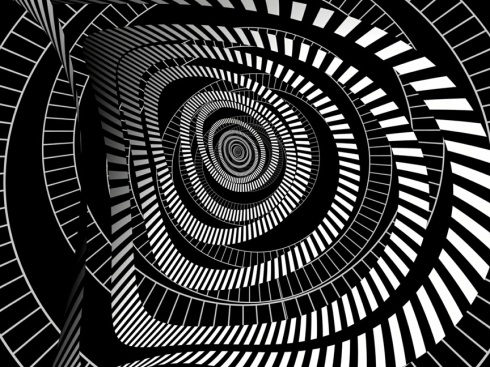MOCAD opened a new show on Friday — two solo exhibitions by two Scandinavians that occupy the raw concrete gallery space (yes, we know it used to be an auto dealership) with an outstretching emptiness, blanched of color, goverened by shape and movement, flickers of shadow and whiteness, mechanical noises and unpeopled silences.
Except, of course, the opening was crowded with people and people-made sounds, and showcased a rowdy family of petulant robots (by Apetechnology) with huge lightbulbs for heads and swathed in conical rubber capes, rocking on their wheels, hollering at the crowd and flashing strobes in everyone’s bewildered, delightedly terrified faces. And the night’s musical guest, Caroliner — a group of humans, presumably, underneath the puppets, future-tribal headpieces and layer upon layer of day-glo — happened to be a very loud group of (neon-bedecked, glow-in-the-dark) humans.

Caroliner
Under the racket of the performance art, Alexander Gutke’s slide and video installations reminded me of a world that everyone had to flee on rather short notice, never to return, leaving their projectors and slide carousels running. Now they only play jammed-up loops of dust and burning cellulose, animations of physics and photographs of machines.

Alexander Gutke, Lighthouse, 2006. Kodak carousel slide projector, 81 slides, timer, stand Ed. 4 + AP
Courtesy Galerija Gregor Podnar, Berlin
Anne Lislegaard: 2062 is a more straightforward (at least in concept) interpretation of the future as seen through a telescope of science fictions — specifically, those of Stanley Kubrick (or Arthur C. Clarke?), Ursula K. LeGuin, J.G. Ballard, Spielberg’s Close Encounters of the Third Kind and others.

Anne Lislegaard, The Left Hand of Darkness, 2008. The Left Hand of Darkness. 2008. Three-channel video installation. Courtesy of the artist and Murray Guy, New York.
We found it harder to concentrate on Lislegaard’s denser installation of jutting, black-and-white 3D animations (projected on imposing tilted screens) and her interplay of time, sound, motion and space over the din of the party, so we left a closer look for a future visit. But I was tantalized by the sense of transportation the exhibit imparted – and in particular, by one pitch-dark, isolated, set-back room in which the only illumination comes from behind a tall black screen.
I was satisfied to let that room be, and made myself comfortable in the enveloping darkness (and the only quiet place in the Museum), until my partner beckoned me closer to the light.
“Sometimes you have to look under the rocks,” he said. Behind the panel is a sassy twist of neon handwriting that spells out, simply, science fiction.
Alexander Gutke and Anne Lislegaard: 2062 runs through December 27. For more information on the exhibitions and a complete list of programs and events, visit MOCAD’s website.

Leave a comment
Comments feed for this article